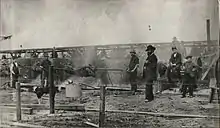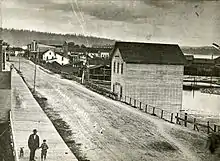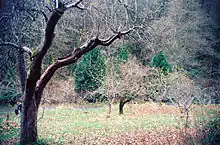A. W. Piper
A. W. Piper (1828 – November 11, 1904) was a Seattle, Washington pioneer whose name was given to Piper Orchard, Pipers Creek and Piper's Canyon in Carkeek Park, and who was elected in 1877–1878 a socialist Seattle City Council member.[3][4][5] He owned a bakery known for its artistic confections that served Seattle and the Puget Sound region.[1]
Andrew William Piper | |
|---|---|
 Piper in 1883 by Henry Villard from Asahel Curtis' collection | |
| Born | ca. March 1828[1] |
| Died | November 11, 1904 (aged 76) Seattle, Washington, US |
| Resting place | Lake View Cemetery, Lot 184[2] 47.633242°N 122.317098°W |
| Citizenship | US |
| Occupation | Baker, confectioner, artist, politician |
| Organization | Puget Sound Candy Manufactory, aka Piper's Bakery |
| Known for | Piper Orchard, Pipers Creek, Piper's Canyon, Carkeek Park, socialist member of Seattle City Council |
Notable work | "Piper's Cream Cakes"[1] |
| Political party | Socialist |
| Spouse(s) | Wilhelmina "Minna" Piper (1835–1930) |
| Children | 11 children, incl. Oscar Albert Piper (1876–1968), Walter Piper[1] |
Life
Piper was born in Kissingen, Bavaria around March 1826.[1][6][7] He was educated as an artist,[7][8] and emigrated to America in 1847 at age 19.[6][7] In New Orleans he met Wilhelmina ("Minna") Hausman (June 1834 – 1930[1]), who was from the Hanover area of Germany,[1][8] and had come to America in 1853.[1] The 1900 Census showed they had been married for 48 years, since around 1852,[1] or else they were married a little later, in San Francisco in 1853,[6] crossing the Isthmus of Panama to get to California.[1][7] They lived in San Francisco for 20 years,[6] and their first five children were born there.[1] Piper attended the San Francisco Mechanics' Institute, receiving a certificate for "best specimens of ornamental sugar work" dated September 1857.[8]
By 1871 they were living in Victoria, British Columbia, where Piper was a confectioner on Government and Fort Streets.[9] Three of the Piper's children were born in Victoria,[1] and it was here that historian Thomas W. Prosch first met Piper.[6] Prosch said Piper's store was popular and attracted visitors from around the region.[6] An 1873 newspaper announcement said an Andrew William Piper, baker and confectioner of Government Street, declared bankruptcy in Victoria, B.C. on December 4, 1872.[10]

The Pipers came to Seattle in 1873.[6][11] He owned a Bavarian style konditorei, the Puget Sound Candy Manufactory, in Seattle's Pioneer Square on Front St. between Cherry and Mill Streets.[1][12][13] A typical konditorei is much more than a bakery, making candies and many other types of confections.[8] He was known for his wedding cakes and other creative, artistic confections,[11] including "Piper's Cream Cakes" (or "Dream Cakes"[2][14]) that were especially popular in the 1870s, made from a recipe Piper never revealed.[1] By the 1880s Piper employed a number of assistants.[11] Prosch said that Seattle's Lake Union often froze over in winter, and that in those days, before Seattle's ice factory was built in 1882,[15] Piper would harvest large blocks of ice from the lake, which he saved until summer for making ice cream.[16]
In 1876, A. W. Piper ran for Seattle City Council representing the Third Ward and lost, coming in fourth out of five candidates.[17] On his second run, for the Third Ward again, he just barely won a seat on the Council, in 1877,[5][17] on the socialist ticket.[1] From 1890–1896 the city charter was amended to use a bicameral system, made up of a House of Delegates with to members from each of the city's now eight wards, where previously there had been three wards, and a nine-member at-large Board of Aldermen.[5] Piper ran for the Board of Aldermen in 1896, losing and coming third.[17] He was also a socialist (or Populist[1]) nominee for Seattle Mayor.[6]
Piper was known as an artist,[6] having several unsigned paintings hanging in museums and the homes of pioneers,[1][11] and he sculpted in clay and stone.[3] He also drew political cartoons and news illustrations, including the lynching of three suspected murderers in Henry Yesler's yard in 1882.[18][19][20][21] Many of the cartoons are in the University of Washington Libraries digital archives.[8]

On September 14, 1883, to commemorate the completion of the transcontinental Northern Pacific Railroad, celebrated that September 8 in Montana, Seattle threw its first potlatch with the railroad's president Henry Villard in attendance. Piper was put in charge of the jubilee's barbecue, held on the former grounds of the University of Washington.[6][22]
Piper's bakery was destroyed in the Great Seattle Fire of June 6, 1889.[8] All bakeries and candy makers in Seattle were destroyed in the Fire, and the industry reorganized afterwards, with some of the old businesses rebuilt and other new ones established.[23] Piper did not rebuild, heading for Alaska instead.[6]
The Portland Morning Oregonian of May 4, 1888, reported that a newspaper called the Enterprise, intended to rival the size of the Seattle Post-Intelligencer, was incorporated with $25,000 capital by Piper with W.E. Lockard, H.F. Jones, J.C. Mavel and J.F. McDonald,[24] just over a year before the Great Seattle Fire. After the Fire he ran a bakery in a tent in Nome, Alaska, for two years,[6] then returned to Seattle as a farmer and orchardist.[8] Their 80-acre (32 ha) farm on Pipers Creek was founded c. 1880.[25]

The Pipers had 11 children, the first five born in San Francisco (1854, 1859, 1861, 1865, and 1867), three in Victoria, B.C. (1868, 1870 and 1873), and the last three in Seattle (1876, 1878 and the eleventh, born after 1879 and died by 1900).[1]
Piper was a Freemason,[6] president of Seattle Turn Verein (society) (see Turners; a liberal German movement which produced several members of the Revolution of 1848),[27] and member of the Seattle Liederkranz, a German cultural club that sang and danced.[28] He was also a member of the Pioneer Association of the State of Washington, a society of the state's early settlers,[7] and he was one of the founders of the Seattle Chess Club and the Seattle Amateur Rifle Association.[29]
Piper died at home, at 1523 Boren Ave., on November 11, 1904, at age 76, after a long illness.[6][30] His funeral was at the Unitarian Church on Seventh Ave. and Union St. the following Sunday, November 13, under the auspices of St. John's Lodge No. 9, the local Masonic Lodge.[30] He was buried at Lake View Cemetery, Lot 184.[2]
Piper legacy in Seattle

A. W. Piper may have been the first of several Socialists or Communists on the Seattle City Council, including Hugh De Lacy, elected in 1937, who was a secret member of Communist Party USA; and Kshama Sawant, who won a seat in 2013 as Socialist Alternative party member.
His property on Lake Washington became Naval Air Station Sand Point, what is now Seattle's Magnuson Park.[14] Piper's farm and orchard at Pipers Creek are now part of Seattle's Carkeek Park. The trees are still productive, and an annual Festival of Fruit is held there.[4]
The land at Carkeek Park, called "the Ranch" by the Piper family, had been previously logged twice, and A. W. Piper's eighth child, Walter (June 27, 1873, Victoria, B.C.–September 20, 1914, Seattle), tried to log the land a third time, but did not make money.[8][31] Walter was a junior partner in the successful Piper & Taft Sporting Goods, which was later bought by Eddie Bauer.[8]
Piper's son Oscar Albert Piper (b. 1876) was one of the University of Washington's first graduated engineers.[32] He joined the United States Army Corps of Engineers, helped plan the Lake Washington Ship Canal,[33] and served as Seattle's acting City Engineer in 1934 and 1936.[34]
A. W. and Minna Piper were nominated as among the 150 most influential individuals in Seattle's history in the 2001 Museum of History and Industry–Seattle Times "Metropolist" project.[35]

Election results
- 1876 City Council, Third Ward[17]
| Candidate | Votes |
|---|---|
| William N. Bell (winner) | 74 |
| C.W. Moore (winner) | 54 |
| Thomas J. Jackson | 30 |
| A.W. Piper | 28 |
| Reuben Doyle | 23 |
| Candidate | Votes |
|---|---|
| Arthur A. Denny (winner) | 72 |
| A.W. Piper (winner) | 35 |
| William N. Bell | 35 |
- 1896 Board of Aldermen, Fifth Ward[17]
| Candidate | Votes |
|---|---|
| George F. Raymond (winner) | 462 |
| Gus Brown | 326 |
| A.W. Piper | 125 |
References
- SGS Bulletin 1997.
- Ferguson 1995.
- Dorpat 1999.
- Stripling 2004.
- Seattle Municipal Archives.
- Prosch 1904.
- Seattle Times obituary 1904.
- Friends of Pipers Orchard 1985.
- Victoria directory 1871.
- Pooley 1873.
- Bagley 1916, p. 631.
- Curtis & Miller 1878.
- Front Street, 1874.
- Shannon 2007, p. 47.
- Bagley 1916, pp. 629–630.
- Pioneer Declares 1909.
- Historical Election Results for Seattle.
- Stein 2000.
- Public Hanging 1882.
- Morgan 1951.
- Speidel 1967.
- Curtis 1883.
- Bagley 1916, pp. 631–632.
- Oregonian 1888.
- Case 1984.
- Peterson Brothers 1880.
- Puget Sound Directory, 1887, p. 204
- Funeral notice 1904.
- Bagley 1916, pp. 682, 684.
- Deaths and Funerals; Piper 1904.
- Late Walter F. Piper Prominent in City 1914.
- Superintendent of Public Instruction 1898.
- Seattle Times 1966.
- Seattle City Clerk 1997.
- Metropolist 2001.
- Bagley 1916, p. 560.
Sources
- Bagley, Clarence (1916), History of Seattle from the Earliest Settlement to the Present Time, 2, S.J. Clarke Publishing Company via Google eBooks digitized January 23, 2008, retrieved November 26, 2013
- Biennial Report of the Superintendent of Public Instruction, Washington State Office of Superintendent of Public Instruction, 1898, p. 16
- Case, F. (October 10, 1984), "Living Antique Volunteers with Pluck Are Doing Fruitful Work to Clear an Orchard and Enjoy It Edible History", The Seattle Times – via ProQuest (subscription required) , p. E1
- Curtis, Asahel (September 14, 1883). "Seattle's First Potlatch". The Seattle Historical Photograph Collection at the Seattle Public Library. Retrieved November 25, 2013.
- "Deaths and Funerals; Piper", The Seattle Daily Times, Seattle, Washington, p. 26, November 13, 1904
- Curtis & Miller (1878), Front Street, 1878, The Seattle Historical Photograph Collection at the Seattle Public Library, retrieved November 24, 2013
- Dorpat, Paul (January 1, 1999), Now & Then – Seattle's Front Street (now 1st Avenue); Essay 2585, HistoryLink, retrieved November 20, 2013
- Ferguson, Robert L. (1995), The pioneers of Lake View: a guide to Seattle's early settlers and their cemetery, Thistle Press
- "Front Street, 1874". The Seattle Historical Photograph Collection at the Seattle Public Library. 1874.
- "Funeral of A. W. Piper; Services for Pioneer Business Man of Seattle are Well Attended", Seattle Times via NewsBank, p. 7, November 14, 1904
- "Historical Election Results for Seattle". seattle.gov. City of Seattle. Retrieved November 23, 2013.
- Morgan, Murray (1951), Skid Road; An Informal Portrait of Seattle, Viking Press, pp. 80–82
- "News of the Northwest; Washington Territory", The Morning Oregonian – via NewspaperArchive.com (subscription required) , Portland, Oregon, 28 (8624), p. 6, May 4, 1888
- Peterson Brothers (1880), Front Street, 1880, Seattle, Washington: The Seattle Historical Photograph Collection at the Seattle Public Library
- "Pioneer Business Man Dead; A. W. Piper Came to Seattle From California Thirty Years Ago". Seattle Times via NewsBank. November 11, 1904. p. 4.
- "Pioneer Declares Winter Not So Cold; Thomas W. Prosch, Who Has Spent Fifty-one Seasons on Puget Sound Recalls Freezups of Early Days". Seattle Times via NewsBank. January 12, 1909. p. 7.
...Before there was an ice factory in Seattle, the city depended on Lake Union entirely for its supply. A. W. Piper, our original ice cream maker and confectioner, used to cut huge blocks of ice out of the lake every winter so the pioneers could have cool refreshments the following summer.
- "'Pioneer' Engineer Is 90 Years Old", The Seattle Times, July 13, 1966
- Piper Oral History Meeting – February 20, 1985 and 1984 Seattle Times Article, Friends of Pipers Orchard, February 20, 1985, retrieved November 20, 2013
- Pooley, Chas. E. (January 3, 1873), "In the Supreme Court of Victoria; In Bankruptcy", The Victoria Daily Standard, Victoria, British Columbia
- Prosch, Thomas Wickham (November 12, 1904), "A. W. Piper Dies at His Residence; Aged Pioneer Business Man and Socialist Succumbs After a Long Illness", Seattle Post-Intelligencer, p. 7
- "Public Hanging". The Seattle Historical Photograph Collection. Seattle Public Library. 1882.
- "Seattle City Council Members, 1869–Present Chronological Listing". Seattle Municipal Archives by the City of Seattle. Retrieved November 24, 2013.
- "SGS Bulletin". Seattle Genealogical Society via Seattle Public Library. Winter 1997. pp. 61–62. Retrieved November 23, 2013.
- Shannon, Robin (2007), Cemeteries of Seattle; Images of America, Arcadia Publishing, pp. 75–77, ISBN 9780738548135, retrieved November 20, 2013
- Speidel, William C. (1967), Sons of the Profits, Nettle Creek, ISBN 0-914890-00-X
- Stein, Alan J. (January 1, 2000), Lynch mob hangs three men in Seattle on January 18, 1882. Essay 1965, HistoryLink, retrieved November 20, 2013
- Stripling, Sherry (August 15, 2004), "Coming home to Carkeek – Carkeek Park, celebrating its 75th birthday, has seen some hard times. But thanks to dogged supporters, it is a refuge for nature, and nature lovers, in the city", The Seattle Times
- First Victoria BC Directory (PDF), 1871, p. 32, archived from the original (PDF) on December 2, 2013, retrieved November 21, 2013
- "Late Walter F. Piper Prominent in City", Seattle Times via NewsBank, p. 16, September 20, 1914
- "MetropoLIST 150: The 150 Most Influential People in Seattle/King County History. — Nominees", The Seattle Times, 2001, archived from the original on November 16, 2014, retrieved December 1, 2013
Further reading
- Associated Press (May 5, 1903), "Alaska Cases Decided. Circuit Court of Appeals Passes Judgement on Contested Points", Seattle Times via NewsBank, p. 8,
The decision of the Alaskan courts was also affirmed in the case of the suit of A. W. Piper, plaintiff in error, against James Sullivan and T. Cashell, to recover possession of a strip of land in Nome, Alaska, which plaintiff claims was being unlawfully held by the defendants. The verdict for the plaintiff in error was sustained.
- "Carkeek's Piper Orchard still flourishing after 120 years", Ballard News-Tribune, August 19, 2009, retrieved November 20, 2013
- City Engineers, City of Seattle: Office of City Clerk, c. 1997
- "Cheap Fun: Festival of Fruit at historic orchard; Festival of Fruit celebrates heritage fruit trees in Pipers Orchard, at Seattle's Carkeek Park, with cider pressing, a pie contest, educational talks and more.", The Seattle Times, September 22, 2011, archived from the original on December 3, 2013, retrieved November 20, 2013
- Seattle Directory, Polk's Seattle Directory Company, 1890
- Sykes, Karen (March 19, 2003), "Hike Of The Week: Think green amid a wonder of urban trails", Seattle Post-Intelligencer
- "Thanks – The Year Has Been Good To Many Northwest Folks; Here Are A Few Who Have Much To Be Thankful For", The Seattle Times, p. J1, November 26, 1987
- Ward, Kirk C. (ed.), 1876 Seattle Business Directory, Seattle – BL Northup; via Seattle Public Library, retrieved November 23, 2013
External links
| Wikimedia Commons has media related to A. W. Piper. |
- A. W. Piper house 1878 photo from Second Avenue and Pike Street.
- First Ave. near Cherry St. in 1888 including Piper's Bakery. University of Washington Libraries. Special Collections Division. Thomas Prosch Seattle Views Collection.
- A. W. Piper at Find a Grave
